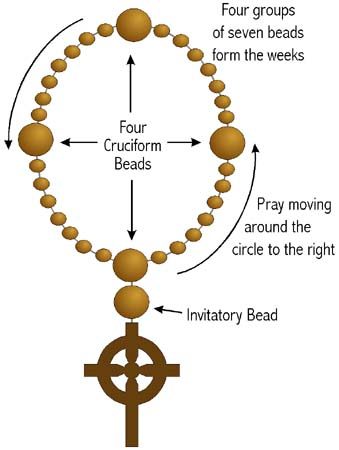
How to Use Prayers Beads--Anglican Rosary
The Anglican Rosary is made up of a Cross and a total of 33 beads; 1 Invitatory Bead, 4 Cruciform Beads and 4 groups of 7 Week Beads. The design is rich in symbolism reminding the user of key tenets of Christian faith and tradition. The total number of beads is 33, the number of years of Christ’s life on earth, reminding us that Jesus is the source of our faith. The Cross recalls the saving grace of God; that God acts in our lives to bring us into the Kingdom of God. The Invitatory bead calls us to prayer; to pray without ceasing. The four Cruciform beads form the shape of a cross, again reminding us of the centrality of Christ in our lives. They also refer to the four points of the compass, the four elements, and the four seasons of the year. Thus we recall our connection with God, the earth, creation and Jesus’ great commission to take the Gospel to the ends of the earth. The seven Week beads represent the seven days of creation, the days of the week, the seasons of the liturgical year and the seven sacraments of the church. Again we recall our connection with God, the creator of all that is. We are also reminded that prayer is the centre Christian life; in our daily prayers and in the liturgy and sacraments of the church. The circular nature of the Rosary formed by the Cruciform and Week beads remind us of the sense of completeness or wholeness that one gains from a deep relationship with God which is achieved through our personal prayer life, and through our communal prayer life with the church.
Information from workshops on Prayer Beads run by Br Nathan-James. For more information on the Anglican Rosary or workshops on Prayer Beads, please contact Br Nathan-James.
© Society of St Francis http://www.franciscan.org.au:80/anglican-rosary/
Why Use Prayer Beads?
Prayer beads are an aid to achieving a type of prayer called Contemplative Prayer. Contemplative Prayer is well described by one of its great modern proponents, the Cistercian priest and monk Fr. Thomas Keating who lives and works at a Benedictine monastery at Snowmass, Colorado.
Fr. Keating tells us that all true prayer is based on a conviction of the presence of the Spirit. True prayer can go in two directions. These are called discursive prayer and contemplative prayer. In discursive prayer, we pray into the Spirit using our thoughts and words. In contemplative prayer, we detach ourselves from our thoughts so as to open up ourselves to letting the Spirit pray in us (Keating, 1994).
So a goal of contemplative prayer is interior silence. Achieving this interior silence is an important step we must take to open up ourselves to letting the Spirit pray in us. We are, in essence, listening rather than speaking (Kelsey, 1976).
There are a number of practices that “spontaneously or deliberately” free the mind of dependence on thinking to go to God (Keating). These practices include lectio divina (a method of prayerfully reading the Scriptures), use of repetitive prayers such as the Jesus Prayer or the Hail Mary, the use of a repetitive mantra (often a word or short phrase such as “love” or “peace” or “Come Lord Jesus” or many, many others), the Veneration of Icons, devotionals such as the Stations of the Cross, and prayer beads.
So just what do prayer beads do? There may be no better description than that of a prayer bead authority, Fr. Basil Pennington of the Roman Catholic Dominican Order.
Fingering beads often helps our concentration. This is one of their greater benefits. While they occupy and integrate our external senses into our prayer, our mind is left freer to attend to its own level of reality.
There are mysteries to be pondered and experiences to be had, moments of enlightenment and touches of the divine, while the beads and their accompanying formulas keep the lower faculties occupied. Even when the rational mind is occupied in conversation or some other simple task, beads can be support the spirit in its course of prayer. Deliberately holding the beads can in itself be prayer, especially when the mind seems unable to formulate any meaningful thoughts. The chain of beads can reach far beyond itself, bonding us with a higher power – with heaven itself. A lifetime of absorbed myth, rich legends, frequent use, and association with significant moments can endow a little chaplet (a small loop of beads) with powerful symbolic meanings very personal to the hand and heart that hold it (Pennington, 1985).
So for people used to discursive prayer, prayer beads are a step toward contemplative prayer, one way to take the step from “talking to God” to “listening to God.”
Keating, Fr. Thomas, Open Mind, Open Heart, The Contemplative Dimension of the Gospel, the Continuum Publishing Company, New York, 1994, particularly pages 13, 145, and 147.
Kelsey, Fr. Morton T., The Other Side of Silence, A Guide to Christian Meditation, Paulist Press, 1976, p. 93.
Pennington, Fr. M. Basil, Praying by Hand, Rediscovering the Rosary as a Way of Prayer, Harper San Francisco, 1985, p. 4, et. Seq.
© Copyright MMIX Full Circle Beads http://www.fullcirclebeads.com/prayers.html
Prayers to Use with the Prayer Beads
Prayer of St. Francis
Prayer for Recovery
Celtic Prayer
Simple Prayer
Evening Prayer